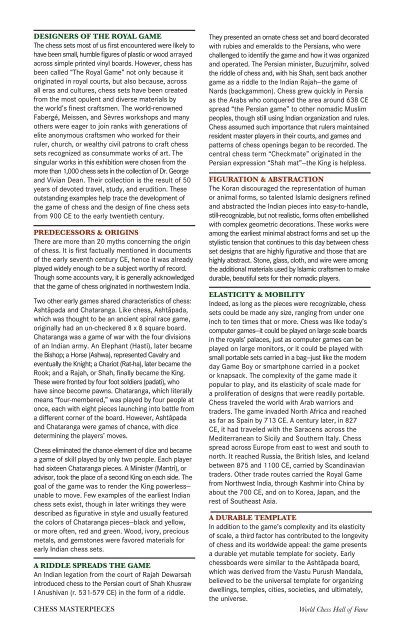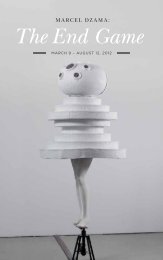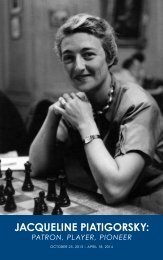CHESS MASTERPIECES
CHESS MASTERPIECES - World Chess Hall of Fame
CHESS MASTERPIECES - World Chess Hall of Fame
- No tags were found...
You also want an ePaper? Increase the reach of your titles
YUMPU automatically turns print PDFs into web optimized ePapers that Google loves.
DESIGNERS OF THE ROYAL GAMEThe chess sets most of us first encountered were likely tohave been small, humble figures of plastic or wood arrayedacross simple printed vinyl boards. However, chess hasbeen called “The Royal Game” not only because itoriginated in royal courts, but also because, acrossall eras and cultures, chess sets have been createdfrom the most opulent and diverse materials bythe world’s finest craftsmen. The world-renownedFabergé, Meissen, and Sèvres workshops and manyothers were eager to join ranks with generations ofelite anonymous craftsmen who worked for theirruler, church, or wealthy civil patrons to craft chesssets recognized as consummate works of art. Thesingular works in this exhibition were chosen from themore than 1,000 chess sets in the collection of Dr. Georgeand Vivian Dean. Their collection is the result of 50years of devoted travel, study, and erudition. Theseoutstanding examples help trace the development ofthe game of chess and the design of fine chess setsfrom 900 CE to the early twentieth century.PREDECESSORS & ORIGINSThere are more than 20 myths concerning the originof chess. It is first factually mentioned in documentsof the early seventh century CE, hence it was alreadyplayed widely enough to be a subject worthy of record.Though some accounts vary, it is generally acknowledgedthat the game of chess originated in northwestern India.Two other early games shared characteristics of chess:Ashtāpada and Chataranga. Like chess, Ashtāpada,which was thought to be an ancient spiral race game,originally had an un-checkered 8 x 8 square board.Chataranga was a game of war with the four divisionsof an Indian army. An Elephant (Hasti), later becamethe Bishop; a Horse (Ashwa), represented Cavalry andeventually the Knight; a Chariot (Rat-ha), later became theRook; and a Rajah, or Shah, finally became the King.These were fronted by four foot soldiers (padati), whohave since become pawns. Chataranga, which literallymeans “four-membered,” was played by four people atonce, each with eight pieces launching into battle froma different corner of the board. However, Ashtāpadaand Chataranga were games of chance, with dicedetermining the players’ moves.Chess eliminated the chance element of dice and becamea game of skill played by only two people. Each playerhad sixteen Chataranga pieces. A Minister (Mantri), oradvisor, took the place of a second King on each side. Thegoal of the game was to render the King powerless—unable to move. Few examples of the earliest Indianchess sets exist, though in later writings they weredescribed as figurative in style and usually featuredthe colors of Chataranga pieces—black and yellow,or more often, red and green. Wood, ivory, preciousmetals, and gemstones were favored materials forearly Indian chess sets.A RIDDLE SPREADS THE GAMEAn Indian legation from the court of Rajah Dewarsahintroduced chess to the Persian court of Shah KhusrawI Anushivan (r. 531-579 CE) in the form of a riddle.They presented an ornate chess set and board decoratedwith rubies and emeralds to the Persians, who werechallenged to identify the game and how it was organizedand operated. The Persian minister, Buzurjmihr, solvedthe riddle of chess and, with his Shah, sent back anothergame as a riddle to the Indian Rajah—the game ofNards (backgammon). Chess grew quickly in Persiaas the Arabs who conquered the area around 638 CEspread “the Persian game” to other nomadic Muslimpeoples, though still using Indian organization and rules.Chess assumed such importance that rulers maintainedresident master players in their courts, and games andpatterns of chess openings began to be recorded. Thecentral chess term “Checkmate” originated in thePersian expression “Shah mat”—the King is helpless.FIGURATION & ABSTRACTIONThe Koran discouraged the representation of humanor animal forms, so talented Islamic designers refinedand abstracted the Indian pieces into easy-to-handle,still-recognizable, but not realistic, forms often embellishedwith complex geometric decorations. These works wereamong the earliest minimal abstract forms and set up thestylistic tension that continues to this day between chessset designs that are highly figurative and those that arehighly abstract. Stone, glass, cloth, and wire were amongthe additional materials used by Islamic craftsmen to makedurable, beautiful sets for their nomadic players.ELASTICITY & MOBILITYIndeed, as long as the pieces were recognizable, chesssets could be made any size, ranging from under oneinch to ten times that or more. Chess was like today’scomputer games—it could be played on large scale boardsin the royals’ palaces, just as computer games can beplayed on large monitors, or it could be played withsmall portable sets carried in a bag—just like the modernday Game Boy or smartphone carried in a pocketor knapsack. The complexity of the game made itpopular to play, and its elasticity of scale made fora proliferation of designs that were readily portable.Chess traveled the world with Arab warriors andtraders. The game invaded North Africa and reachedas far as Spain by 713 CE. A century later, in 827CE, it had traveled with the Saracens across theMediterranean to Sicily and Southern Italy. Chessspread across Europe from east to west and south tonorth. It reached Russia, the British Isles, and Icelandbetween 875 and 1100 CE, carried by Scandinaviantraders. Other trade routes carried the Royal Gamefrom Northwest India, through Kashmir into China byabout the 700 CE, and on to Korea, Japan, and therest of Southeast Asia.In 1275, Jacobus de Cessolis, a Dominican monk inLombardy, used the game of chess as a basis for amajor sermon on morality discussing each person’ssocial status and responsibilities. Originally publishedas Liber de moribus hominum et officiis nobelium (Book ofthe Manners of Men and the Offices of the Nobility),it became so popular that it was translated, re-copied,and illustrated in every European language. WilliamCaxton’s 1475 version, illustrated with simple woodcuts andsimply re-titled The Game and Playe of the Chesse,was the second book published in the English language.In 1284, King Alfonso X the Wise of Castile and Leonenlisted numerous scholars and artists to producethe Libros del Axedrez, Dados et Tablas, or Book ofGames and Tables, which he organized and edited.He contrasted dice, a game of chance, with chess,a game of skill, in order to debate the larger topic ofwhether life itself was driven by fate or instead, wasa matter of free will, which he equated with games ofskill, chess the first among them.MUTABILITY & REPERTORY ACTORSThe longevity of the standard chess pieces over centuriesis in part due to their mutability as characters. Throughouthistory, inspired artisans have used the chess pieces asrepertory actors, recasting them in the topical rolesof the day to be played out upon the 64 squares oftheir chessboard stage. Chess sets in this exhibitionhave immortalized the courts of Catherine the Great,Napoleon, and Czar Nicolas II. They commemoratecultural conflicts such as Indians vs. British (the JohnStyle Set), Assyrians vs. Egyptians, Europeans vs. Africansand Communists vs. Capitalists (Soviet PropagandaSet). They have distilled the dramas of basic humannature such as the Battle of the Sexes and Good vs. Evil.Shakespeare’s plays, like chess games, were rife withseductions, bluffs, betrayals, and murder. Hence, itmay come as no surprise that there are chess setsportraying the characters of Macbeth, or that HowardStaunton, the English chess champion for whom theworld’s most ubiquitous chess set is named, was alsoa leading Shakespeare scholar.MATERIAL & TECHNIQUESChess sets of every country had basically the sameelements, and since they were readily portable,they were readily comparable country to country,culture to culture. This challenged the courtiers andinspired the craftsmen of each region to seek outthe finest materials and devise the most advancedand ingenious techniques of fabrication. Augustusthe Strong of Saxony went so far as to imprison hisleading alchemist for seven years to “incentivize”him to either turn lead into gold or figure out howthe Chinese made porcelain. Though perhaps a bitextreme, it did result in the founding of Meissen, thefirst porcelain works in Europe. Despite efforts tokeep the process secret, twenty-five other porcelainworkshops sprang up by the end of the century creatinga revolution in design using this versatile new medium.A wide variety of materials, from precious metals andgemstones to tortoise shell and paper mâche wereemployed to create the works in this exhibition. However,there is one material that appears in almost half of theworks in this exhibition because it was both preciousand practical: ivory. Until the introduction of plasticsin the twentieth century, ivory from Asian and Africanelephants had been the carving medium of choicethroughout the world. It had been a prized materialsince prehistoric times.Walruses, mammoths (though long extinct), hippopotami,and narwhals also have been valuable sources of carvingivory. A pleasing creamy-white in its natural state,ivory could be painted or stained a rainbow of colorsand had a tight, even grain, finer than any wood. Hence,it would hold exceptionally fine detail, could be buffedto a lustrous finish, and was durable enough to lastgenerations. Demand for finely carved ivory goodshas never abated, though declining herds led theConvention on International Trade in Endangered Species(CITES) to put the Asian elephant on its endangeredlist in 1975 and the African elephant in 1990. Thismakes international trade in ivory illegal and helps todiscourage interest in any newly made ivory goods.BOARDS AS ARTMany craftsmen did not stop when they completedthe 32 chess pieces. They regarded the chessboardsas equally important expressions of their artistry: eachboard became a detailed stage, a private little universe inwhich their characters would play out their combativedramas. In Europe between 1100 and 1200, the transitionwas made to checkered boards, which multiplied designers’opportunities for decorative effects while also aidingplayers’ calculation of moves. In fact, checkered boardswere adapted as tools to aid accounting calculationsas well, giving rise to the job title “Exchequer.”STRANGE BEAUTIESBeneath the strange beauties that abound in theseworks runs a deep, intense current of human ingenuity,technical innovation, consummate craftsmanship,and brilliant artistry. While viewing these creations,one should consider that all but one or two of the worksin this exhibition were made before the availability ofelectric lights or power tools. There were no digitalcalipers to perfectly measure and lay out designs,no super-sharp carbide drills or chisels or carvingknives. The vast majority of these craftsmen workedeither under sunlight or were aided only by the frustratingflicker of candle or lamp lights and used basic manmadetools for carving and sculpting. This makes theseworks all the more amazing.It is said that there are currently more than 500,000,000chess players in the world and that there are morepotential chess moves than there are atoms in theuniverse. These highlights from the Dean Collectionwould suggest that there is also infinite variety andpossibilities in the design of chess sets for us to study,learn from, and enjoy.Larry List,Consulting Curator<strong>CHESS</strong> <strong>MASTERPIECES</strong>A DURABLE TEMPLATEIn addition to the game’s complexity and its elasticityof scale, a third factor has contributed to the longevityof chess and its worldwide appeal: the game presentsa durable yet mutable template for society. Earlychessboards were similar to the Ashtāpada board,which was derived from the Vastu Purush Mandala,believed to be the universal template for organizingdwellings, temples, cities, societies, and ultimately,the universe.World Chess Hall of Fame<strong>CHESS</strong> <strong>MASTERPIECES</strong>World Chess Hall of Fame






